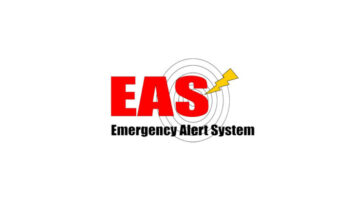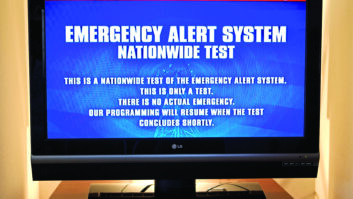WASHINGTON — In the weeks since the national EAS test, the FCC and FEMA have continued to collect data about whether broadcasters received the test message and were able to retransmit it.
Broadcasters have until Dec. 27 to file their reports with the FCC, but some themes have emerged in discussions of what must be done before a presumed second national test.
States and localities test EAS regularly but the November trial was the first nationwide activation of an Emergency Alert Notification code, which the president could use in an emergency.

Clear Channel and FEMA personnel monitored the test from the Clear Channel Emergency Operations Center in Cincinnati. Jeff Bennet of Clear Channel is in foreground; the screen shows custom software that logs EAS activity at the company’s stations.
Some observers deemed the test a failure because the alert was not delivered consistently and audio quality was impaired. Others say discovering such problems was an important goal, and that the test showed a message can in fact be delivered across most of the country from FEMA headquarters.
Connectivity
Regulators told some members of Congress that three of 63 Primary Entry Point stations did not receive the alert.
The Primary Entry Point Advisory Committee, a group that advises FEMA and is made up of representatives from the PEP stations, already had been working with the agency to improve the analog relay, or linking bridge, network that connects FEMA with the PEP stations.
“An IP satellite system is already in place at a handful of PEP stations but will not be turned on until the final PEP station is online,” said Mark Manuelian, PEPAC chair and engineering manager for CBS Radio’s WBZ(AM) in Boston. “We expect to have satellite connectivity complete before the next national test.”
PEPAC members have learned that preliminary reports from FEMA show that about 85 percent of radio stations in the country forwarded the Emergency Action Notification message successfully, Manuelian said.
The PEP station network is in the midst of an expansion that will eventually bring the number of PEP stations to 74, covering about 90 percent of the U.S. population, as Radio World has reported.
“FEMA has recognized that there are pieces that need work,” Manuelian said. “I think we need to look next at equipment and installation on the broadcast side. Most stations had working equipment but not all. Monitoring assignments need to be addressed. If stations need help they should contact their State Emergency Communications Committee.”
Satellite delivery?
Engineers also reported receiving double audio and poor quality audio from high up in the relay chain. FEMA/IPAWS Program Director Manny Centeno told Radio World the originating message was clear for the first four seconds, but that a technical malfunction at the national primary level introduced dual header tones and subsequently decreased the original audio quality of the message for downstream stations. This resulted in distorted audio, according to Centeno.

Waveform is a representative sample from the test, displaying what most people heard, according to FEMA.
EAS equipment manufacturer Digital Alert Systems examined audio captures from the national test and concluded that a problem in a connection between the FEMA Operations Center and PEP station WCCO(AM) in Minneapolis caused the “mystery header” that resulted in looped audio.
“We were able to fully decode one of the feedback headers that erroneously appeared in the audio. The string identifies the PEP station (WCCO) that was the source of the audio,” stated Edward Czarnecki, senior director of strategy, development, & regulatory affairs for Digital Alert Systems.
Neither FEMA nor CBS, the station’s owner, confirmed this detail.
The contamination of the originating alert message delivered via the PEP network is likely to be a focus of attention before a second test.
Maine Association of Broadcasters President Suzanne Goucher said, “In my view, satellite delivery [to PEP stations] should be the primary federal delivery mechanism, with the analog infrastructure of the current system left to be the last-man-standing backup. The system can no longer rely on 1950s technology.”
In Michigan an estimated 10 percent of radio and TV stations had no audio of the test or reported programming problems in their decoders, said Larry Estlack, the state’s EAS committee chairman.
“The relay was obviously the most serious flaw we encountered. I would hope FEMA will examine the PEP transport system, identify its flaws and promptly make needed corrections and improvements,” Estlack said.
Centeno said during a webinar after the test that the time stamp on the originating message was set for three minutes after the hour. While the message did go out at 2 p.m. Eastern, some EAS encoders/decoders relayed the EAN immediately while others held it for a few minutes.
Estlack said, “Some of the new boxes are quite literal, meaning if the internal clock is a few minutes off, it will delay a message, which is what happened in quite a few instances. “We now have such a wide array of new and old EAS receivers out there that there will be issues on how they handle the EAN.”
During the webinar in late November, several EAS participants debated whether the FCC should regulate how encoders/decoders handle time-stamp and double message header issues. Others believe the industry should develop a solution such as best-practices guidance for manufacturers to standardize how units function.
A baseline
All of the corporate-level broadcast engineers contacted by Radio World shared stories of poor audio and minor glitches but agreed that the test served its primary purpose of strengthening the system for the future.
Dave Redmund, vice president of engineering for Townsquare Media, said, “From the observations I have received from across the country, it appears FEMA needs to get its act together before we try [a test] again.”
At Clear Channel Radio, “A vast majority of stations successfully received and retransmitted the EAN alert and the test served the purpose for which it was intended, to identify and remedy any issues to improve the system,” said Jeff Littlejohn, executive vice president of engineering and systems integration.
Clear Channel and FEMA personnel monitored the EAN test from the Clear Channel Emergency Operations Center in Cincinnati, according to Littlejohn.
“It was not quite what we had hoped for,” said Milford Smith, vice president of radio engineering for Greater Media, “but it certainly can serve as a baseline and diagnostic tool to begin and improvement effort for the EAS. This test certainly exposed some significant concerns when expanded to the national level.”
Centeno of FEMA echoed the baseline argument. After the test, he posted a message on the SBE EAS Listserv, emphasizing that he was commenting as an individual and an engineer in this instance. He said that through controlled testing, his team plans to build a list of issues to fix and share it with industry. “We’ve established a baseline. We’re going to re-test,” he stated.
Immediately after the test, concerns flared about how various EAS devices handled the EAN, though they seemed to lessen once federal officials said the looped audio and time stamp issues had been triggered near the top of the broadcast chain, several observers said.
Harold Price, president of EAS manufacturer Sage Alerting Systems, said, “For the most part, EAS equipment at broadcast stations functioned properly. The alert was damaged when it arrived at the broadcasters. It had multiple headers.” FCC Part 11 rules don’t spell out what to do in that case, according to Price. “Each manufacturer made its own decisions at the time the equipment was produced, causing various results.”
Price wants the FCC to initiate a development effort with EAS equipment manufacturers and other stakeholders to recommend technical solutions to handle such scenarios.
Czarnecki of Digital Alert Systems said the company’s DASDEC units performed “very well overall in the field despite the problems encountered with the source audio.”
Decent audio
What Some Stations Told the FCC
Here are excerpts from a few of the Form 3 reports sent to the FCC identifying audio problems with the EAN message. Call signs, licensees and manufacturer information have been omitted at the request of the broadcasters.
“EAN was received … Operator heard first 7–10 seconds of audio ending with ‘United States …’ then silence. Activation tones were audible behind the audio. Audio received and recorded truncated to 13 seconds: The two-tone alert signal for 8 seconds followed by ‘This is a test of the emergency alert system this is only a …’ (silence) was recorded and forwarded by the [EAS encoder/decoder].” Message forward start then ensued.
“EAN was received … The entire message passed through the [EAS encoder/decoder]. The audio had cascading activation tones and audio. The recording shows 8 seconds of two-tone attention signal, then message text. At :13 into the audio activation tones are heard behind the message, followed by the two-tone attention signal and the text again. At :31 seconds the activation tones are heard again further beneath the message.” Message forward start ensued.
“Two problems: First, the message encoding called for a ‘valid time’ beginning at 2:03 p.m. ET. The … EAS box considered this to be a ‘future alert’ and would not send it until the time-of-day actually reached 2:03 p.m. Second, the crosstalk in the audio message included low-level SAME tones, and when the playback of the message reached the point where the SAME tones started, the [encoder /decoder] considered that to be the end of the message, truncated the rest of the audio and sent its own [End of Message] tones.”
“We forwarded the audio we received, but it had substantial crosstalk and noise, as if the original audio message was delayed and repeated at a lower level. SAME encoding and another Attention Signal were audible under the audio message.”
Engineering forums captured the flavor of how broadcast engineers felt following the November test and anecdotal evidence of what went wrong in some instances.
“We know now that EAS can be used to issue a national warning, we just need to solve the problems with the audio at the source. All FEMA needs is a good audio or broadcast engineer,” wrote Adrienne Abbott, adding that broadcasters face these kinds of issues daily.
The Nevada SECC chair stated: “We also have to make sure the public and our media know and understand what happened.”
Broadcast engineering consultant Bob Gonsett, publisher of the CGC Communicator, commented in his newsletter, “The first-ever national EAS test was a serious disappointment. One big problem: The federal government needs to deliver decent audio to the LP1s.” Local Primary stations monitor PEP stations for presidential alerts.
Some commenters on the SBE EAS listserv were more philosophical.
“We need to take into consideration that the people at FEMA are not broadcasters,” stated Jerry Mathis, who handles engineering for Clear Channel/Urban Radio Broadcasting in Tupelo, Miss. “They are not up on all the tricks of the trade we deal with all the time, like computer time synchronization. They are trained more to deal with disasters and government red tape than with IP systems and certainly audio feeds. This was a successful test of the system, the audio problems notwithstanding.”
Gary Timm, chair of the Wisconsin SECC, wrote on the AWARE alert blog, “While some PEP stations reported the test sounded fine, other PEP stations sent the EAS header code but had no audio of the test in states such as Minnesota and Indiana, and another PEP station in Utah never received the test.”
Others said audio and video alerts did not appear in parts of New Mexico and Oregon. Meanwhile, television and cable reportedly also had their own unique challenges.
Next
Immediately after the test, the FCC and FEMA stated: “The nationwide EAS test served the purpose for which it was intended — to identify gaps and generate a comprehensive set of data to help strengthen our ability to communicate during real emergencies.
“Based on preliminary data, media outlets in large portions of the country successfully received the test message, but it wasn’t received by some viewers or listeners. We are currently in the process of collecting and analyzing data, and will reach a conclusion when that process is complete.”
But the need for another national test is clear, observers say. As of late November, a date for another test had not been set. Manuelian, the PEPAC chair, doubted a test would take place before 2013, given that the coming year includes a presidential election cycle.
“This test made a lot of people in high places very, very nervous about the outcome. No one will want to run the risk of another one in 2012,” said Manuelian, emphasizing that he was expressing his personal opinion and not necessarily those of PEPAC or CBS Radio.
Many of the possible “fixes” for EAS require funding and/or more formal and frequent coordination of the public/private partnership of EAS participants.Maine Sen. Susan Collins, ranking Republican on the Senate Homeland Security and Governmental Affairs Committee, announced plans to introduce a bill to establish an IPAWS advisory committee composed of federal, state and local representatives as well as industry groups. The measure would also ensure FEMA uses new technology such as Twitter, Facebook and other social media platforms to deliver emergency alerts on smartphones and other devices (RW, Dec. 1).






